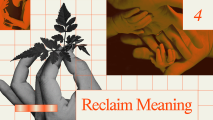Conversations are like movies. They can be entertaining or boring. They can be fun and frothy or serious and dramatic. But, once in a while, there comes a movie that leaves a mark. A great movie will stay with you long after the final credits. So, too, with great conversations, ones where both participants think back on it. You relive what was said, and you reflect on the ideas it birthed.
Good conversations can change who you are; they are the occasional peak experiences that break an otherwise monotonous landscape of banal pleasantries. They can spawn innovations that change the world.
If we recognize conversations as both deeply rewarding and potentially transformative, then we ought to ask how we can have more of them. How can we take steps to have great conversations? How can we limit the boring and forgettable ones? Earlier this year, a paper came out in Science Advances that sought to do just that. A team from the University of Pennsylvania studied 1656 unscripted conversations – the equivalent of 850+ hours of audio and video chats – and analyzed them with “moment-to-moment measures of vocal, facial, and semantic expression, together with an extensive survey of speakers’ postconversation reflections.”
By looking at their results, we can draw out three practical tips to have more great conversations.
Taking turns
A conversation involves a back-and-forth. It means taking turns and letting others speak, as well as listening to what they say. Anecdotally, it seems obvious that if one person “holds the floor” too long, then their partner will be left unsatisfied in the conversation. A conversation is not a lecture, and we get upset when the two are confused. The research seems to support this idea.
Interestingly, this is only true when “taking turns” means finishing your point. Someone might interject, ask questions, or add some commentary, but a “turn” is when you have finished making whatever point you wanted. It need not be that one person speaks alone and unbroken. You can interrupt someone, so long as it continues, rather than derails, their point.
Listen and predict
The time between turns is smaller than the processing time necessary to speak. The average time between participants speaking is 200 ms – roughly the time it takes to blink. This is a figure consistent across most cultures and languages. This time is much shorter than the time needed for your brain to react to a conversation or to “spontaneously” react. This means that during a good conversation, you are predicting what the other person is going to say.
Let’s say someone says to you, “I spilled coffee all over my dress.” You likely predicted the outcome of the sentence at the “spilled” part of the sentence, and so your reaction of “Oh, that’s awful!” comes almost instantaneously.
The lesson from this is that we need to be constantly alert to what the other person is saying; otherwise, this organic turn-taking will feel off. If you’re not listening properly, your brain won’t keep up.
Backchannelling
At a previous job, I used to interview job applicants. One of the instructions I was given then was to try and limit, as much as possible, prompting or leading the interviewee. Don’t nod when someone says something you agree with. Don’t say, “Yeah,” when they’re on the right track. The idea was that you might bias the candidate to say certain things, rather than getting clearest view of the qualities you need for the job.
Conversations are not job interviews. If you are stony-faced and unreactive while somebody’s talking, nobody is going to have fun. You need to encourage your conversation partner with what the study calls “backchannel” words. As the paper puts it, backchannels are “the short words and utterances that listeners use to respond to speakers without taking the floor (e.g., ‘yeah,’ ‘mhm,’ and ‘exactly’).” If someone is speaking for longer than five words, then 65.5% of people will say one of these backchannel words. Backchannel words signal that you’re listening and that you’re engaging. The word “Yeah” accounts for 40% of all backchannel words.
When it comes to meaningful and rewarding conversations, not all backchannel words are the same. Generic words like “yeah” or “mhm” tell the speaker you’re listening and allow them to carry on, but they do not assess what you’re hearing. If you “display a degree of affiliative alignment” by using words like “Wow!”, “Yuck!” or “Oh no!” you mirror the speaker’s emotions and generate greater connection.
The lesson here is to mix up your backchannel words. Saying “Uh huh” is good to a degree, but it’s passive and it’s generic. To elevate your conversation and signal that you’re engaging with what your partner is saying, choose emotional words or evaluative expressions that are the same as the speaker’s.
We’d love to hear from you! If you have a comment about this article or if you have a tip for a future Freethink story, please email us at [email protected].






